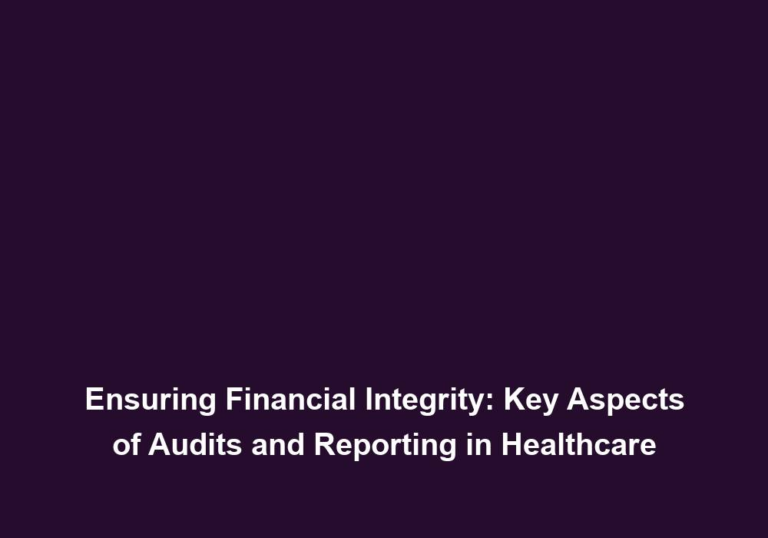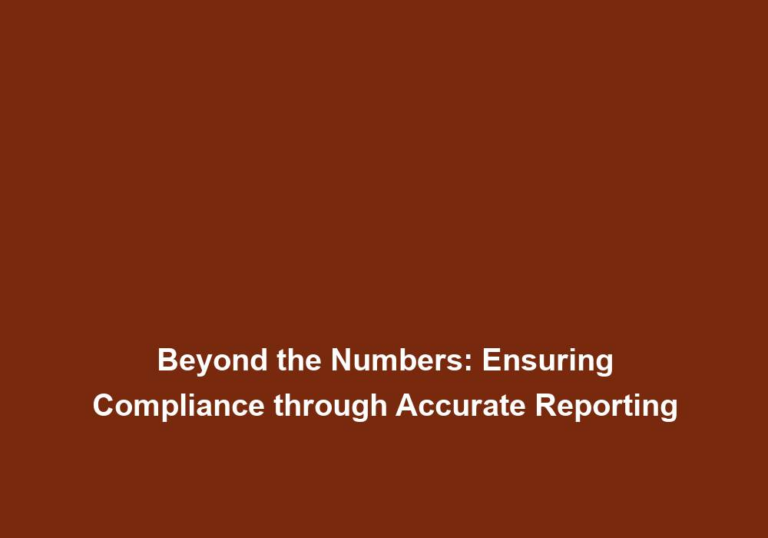Holding Ourselves Accountable: The Role of Compliance Reporting in Healthcare
In the complex world of healthcare, compliance reporting plays a crucial role in ensuring accountability and maintaining high standards of patient care. Healthcare providers and organizations have a responsibility to adhere to legal and regulatory requirements, and compliance reporting serves as a vital tool in achieving these objectives. This article explores the significance of compliance reporting in healthcare and how it contributes to improving overall patient outcomes.
What is Compliance Reporting?
Compliance reporting refers to the process of documenting and reporting on an organization’s adherence to established regulations, policies, and guidelines. In the healthcare industry, this includes adherence to federal, state, and local laws, as well as industry-specific standards and guidelines set by regulatory bodies such as the Centers for Medicare and Medicaid Services (CMS), the Joint Commission, and the Office for Civil Rights (OCR).
Compliance reporting is a comprehensive approach that involves collecting relevant data related to compliance indicators, such as patient outcomes, infection rates, medication errors, and adherence to protocols. This data is typically obtained from electronic health records (EHRs), incident reporting systems, and quality improvement initiatives. Once the data is collected, it needs to be analyzed to identify trends, patterns, and areas that require improvement. Statistical analysis and data visualization techniques can be used to interpret the data effectively.
After analyzing the data, healthcare organizations compile reports that summarize the compliance status and highlight areas of concern. These reports are shared with internal stakeholders, such as healthcare executives, managers, and clinicians, as well as external regulatory bodies, accrediting agencies, and auditors. Based on the findings of the compliance reports, healthcare organizations develop action plans to address any identified deficiencies. These plans include strategies for improving compliance, allocating resources, training staff, and implementing changes in policies or procedures. Regular monitoring and follow-up are essential to ensure the effectiveness of these actions.
The Importance of Compliance Reporting in Healthcare
- Legal and Regulatory Compliance: Compliance reporting ensures that healthcare providers meet legal and regulatory requirements, reducing the risk of penalties, fines, and legal consequences. It helps organizations stay updated with ever-evolving laws, regulations, and guidelines, ensuring they provide safe and effective care to patients.
Compliance reporting is essential for healthcare organizations to stay compliant with federal, state, and local laws. By continuously monitoring and reporting on their adherence to these regulations, healthcare providers can minimize the risk of penalties, fines, and legal consequences. It also helps organizations stay up to date with the latest laws and guidelines, ensuring they provide safe and effective care to patients.
- Patient Safety and Quality of Care: Compliance reporting is closely tied to patient safety and the overall quality of care delivered. By monitoring and reporting compliance data, healthcare organizations can identify areas that require improvement, implement corrective actions, and prevent potential harm to patients. It ensures that patients receive evidence-based, high-quality care while minimizing medical errors and adverse events.
Compliance reporting plays a critical role in improving patient safety and the quality of care delivered. By analyzing compliance data, healthcare organizations can identify areas where patient safety can be improved, such as infection rates or medication errors. This enables them to implement corrective actions and preventive measures, ultimately reducing the risk of harm to patients and improving the overall quality of care.
- Ethics and Accountability: Compliance reporting promotes ethical behavior and accountability within healthcare organizations. It establishes a culture of transparency and honesty, where employees are encouraged to report concerns about potential non-compliance without fear of retribution. This leads to early detection and resolution of compliance issues, fostering trust among patients and stakeholders.
Compliance reporting fosters a culture of ethics and accountability within healthcare organizations. By encouraging employees to report potential non-compliance without fear of retribution, organizations can detect and resolve compliance issues at an early stage. This not only promotes transparency but also builds trust among patients and stakeholders, as they can be assured that the organization is committed to ethical behavior and accountability.
- Financial Integrity: Compliance reporting helps healthcare organizations maintain financial integrity by ensuring accurate billing and reimbursement practices. It prevents fraud, waste, and abuse, safeguarding the financial resources of healthcare systems. Compliance with regulatory requirements related to billing and coding, such as the Health Insurance Portability and Accountability Act (HIPAA), ensures patient privacy and data security.
Compliance reporting is crucial for maintaining the financial integrity of healthcare organizations. By adhering to regulatory requirements related to billing and reimbursement, organizations can prevent fraud, waste, and abuse, safeguarding their financial resources. Compliance with laws such as HIPAA also ensures patient privacy and data security, further enhancing financial integrity.
- Risk Management: Compliance reporting plays a crucial role in identifying and managing risks within healthcare organizations. By monitoring compliance indicators, such as infection rates, medication errors, or patient satisfaction, organizations can proactively address potential risks and implement preventive measures. This leads to improved patient safety, reduced liability, and enhanced organizational resilience.
Compliance reporting is an essential component of risk management in healthcare organizations. By monitoring compliance indicators, organizations can identify potential risks and take proactive measures to mitigate them. For example, monitoring infection rates can help identify areas where infection control protocols need improvement. By addressing these risks early on, organizations can enhance patient safety, reduce liability, and build organizational resilience.
Best Practices for Effective Compliance Reporting
To ensure the effectiveness of compliance reporting, healthcare organizations should consider the following best practices:
- Establish Clear Policies and Procedures: Clear policies and procedures should be in place, outlining the expectations for compliance reporting. This includes guidelines on data collection, analysis, reporting formats, and frequency. Training programs should be provided to employees to ensure they understand these policies and procedures.
Establishing clear policies and procedures is essential for effective compliance reporting. By providing guidelines on data collection, analysis, reporting formats, and frequency, organizations can ensure consistency and accuracy in compliance reporting. It is also crucial to provide training programs to employees to ensure they understand these policies and procedures and can effectively contribute to compliance reporting efforts.
- Utilize Technology Solutions: Healthcare organizations can leverage technology solutions, such as compliance management software, to streamline data collection, analysis, and reporting processes. These tools can automate data aggregation, track compliance indicators, generate reports, and facilitate real-time monitoring of performance.
Technology solutions play a significant role in enhancing the efficiency and accuracy of compliance reporting. Compliance management software can automate data collection, analysis, and reporting processes, reducing the manual effort required. It can also provide real-time monitoring of compliance indicators, enabling organizations to identify and address issues promptly.
- Promote a Culture of Compliance: Creating a culture of compliance is essential for effective reporting. This involves fostering a sense of responsibility, accountability, and ethical behavior among employees. Regular training, open communication channels, and a robust reporting system are key components of such a culture.
Promoting a culture of compliance is crucial for successful compliance reporting. Organizations should foster a sense of responsibility and accountability among employees, emphasizing the importance of ethical behavior. Regular training programs can help employees stay updated with compliance requirements, while open communication channels and a robust reporting system encourage the reporting of potential non-compliance issues.
- Engage Stakeholders: Engaging stakeholders, including patients, clinicians, administrators, and regulatory bodies, is crucial for successful compliance reporting. Transparency and collaboration foster trust and ensure that compliance efforts align with the overall goals of patient safety and quality of care.
Engaging stakeholders is an essential aspect of compliance reporting. By involving patients, clinicians, administrators, and regulatory bodies, organizations can ensure that compliance efforts are aligned with the overall goals of patient safety and quality of care. Transparency and collaboration foster trust among stakeholders and encourage their active participation in compliance reporting initiatives.
Conclusion
Compliance reporting plays a pivotal role in healthcare by upholding legal and regulatory requirements, improving patient safety, maintaining financial integrity, and managing risks. It promotes ethical behavior, accountability, and a culture of transparency within healthcare organizations. By following best practices and utilizing technology solutions, healthcare providers can ensure effective compliance reporting, leading to enhanced patient outcomes and the delivery of high-quality care.







